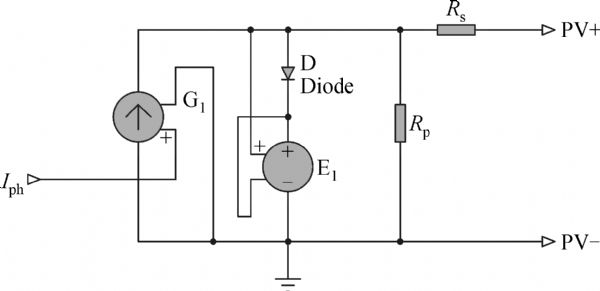

A comprehensive simulator for assessing the reliability of a photovoltaic panel peak power tracking system
Received date: 08 Apr 2014
Accepted date: 29 Sep 2014
Published date: 29 May 2015
Copyright
When designing a maximum power point tracking (MPPT) algorithm, it is often difficult to correctly predict, before field testing, the behavior of this MPPT under varying solar irradiation on photovoltaic (PV) panels. A solution to this problem is to design a maximum power point trackers simulator of a PV system used to test MPPT algorithms. This simulator must have the same role as the MPPT card of the PV panel and thus will fully emulate the response of a real MPPT card of the PV panel. Therefore, it is a good substitute to help to test the peak power trackers of the PV system in the laboratory. This paper describes a simple peak power trackers simulator of the PV system which has a short response time thus, can be used to test MPPT algorithms under very rapid variation condition. The obtained results and the theoretical operation confirm the reliability and the superior performance of the proposed model.

Nabil KAHOUL , Mourad HOUABES , Ammar NEÇAIBIA . A comprehensive simulator for assessing the reliability of a photovoltaic panel peak power tracking system[J]. Frontiers in Energy, 2015 , 9(2) : 170 -179 . DOI: 10.1007/s11708-015-0353-y
| 1 |
Kim I S, Kim M B, Youn M J. New maximum power point tracker using sliding-mode observer for estimation of solar array current in the grid-connected photovoltaic system. IEEE Transactions on Industrial Electronics, 2006, 53(4): 1027–1035
|
| 2 |
Xiao W, Lind M G J, Dunford W G, Capel A. Real-time identification of optimal operating points in photovoltaic power systems. IEEE Transactions on Industrial Electronics, 2006, 53(4): 1017–1026
|
| 3 |
Li Y, Lee T, Peng F, Liu D. A hybrid control strategy for photovoltaic simulator. In: Proceedings of 2009 24th Annual IEEE Applied Power Electronics Conference and Exposition. Washington DC, 2009, USA, 899–903
|
| 4 |
Subudhi B, Pradhan R. A comparative study on maximum power point tracking techniques for photovoltaic power systems. IEEE Transactions on Sustainable Energy, 2013, 4(1): 89–98
|
| 5 |
Santos J L, Antunes F, Chehab A, Cruz C. A maximum power point tracker for PV systems using a high performance boost converter. Solar Energy, 2006, 80(7): 772–778
|
| 6 |
Yang Y, Zhao F P. Adaptive perturb and observe MPPT technique for grid connected photovoltaic inverters. Procedia Engineering, 2011, 23: 468–473
|
| 7 |
Wang J C, Shieh J C, Su Y L, Kuo K C, Chang Y W, Liang Y T, Chou J J, Liao K C, Jiang J A. A novel method for the determination of dynamic resistance for photovoltaic modules. Energy, 2011, 36(10): 5968–5974
|
| 8 |
Kahoul N, Houabes M, Sadok M. Assessing the early degradation of photovoltaic modules performance in the Saharan region. Energy Conversion and Management, 2014, 82: 320–326
|
| 9 |
Yordanov G H, Midtgård O M, Saetre T O. Series resistance determination and further characterization of c-Si PV modules. Renewable Energy, 2012, 46: 72–80
|
| 10 |
Tey K S, Mekhilef S. Modified incremental conductance MPPT algorithm to mitigate inaccurate responses under fast-changing solar irradiation level. Solar Energy, 2014, 101: 333–342
|
| 11 |
Safari A, Mekhilef S. Implementation of incremental conductance method with direct control. 2014-02-25
|
| 12 |
Scheurer A, Ago E, Hidalgo J S, Kobosko S. Photovoltaic MPPT charge controller. 2014-02-25
|
| 13 |
Nolan T. Peak power tracker circuit description. 2014-02-26
|
| 14 |
Houssamo I, Locment F, Sechilariu M. Experimental analysis of impact of MPPT methods on energy efficiency for photovoltaic power systems. International Journal of Electrical Power & Energy Systems, 2013, 46: 98–107
|
| 15 |
Ishaque K, Salam Z, Amjad M, Mekhilef S. An improved particle swarm optimization (PSO) based MPPT for PV with reduced steady-state oscillation. IEEE Transactions on Power Electronics, 2012, 27(8): 3627–3638
|
| 16 |
Hussein K H, Muta I, Hoshino T, Osakada M. Maximum photovoltaic power tracking: an algorithm for rapidly changing atmospheric conditions. IEE Proceedings–Generation, Transmission and Distribution, 1995, 142(1): 59–64
|
| 17 |
Ahmed M. Atallah
|
| 18 |
Tey K S, Mekhilef S. Modified incremental conductance algorithm for photovoltaic system under partial shading conditions and load variation. IEEE Transactions on Industrial Electronics, 2014, 61(10): 5384–5392
|
| 19 |
Seyedmahmoudian M, Mekhilef S, Rahmani R, Yusof R, Renani E T. Analytical modeling of partially shaded photovoltaic systems. Energies, 2013, 6(1): 128–144
|
/
| 〈 |
|
〉 |